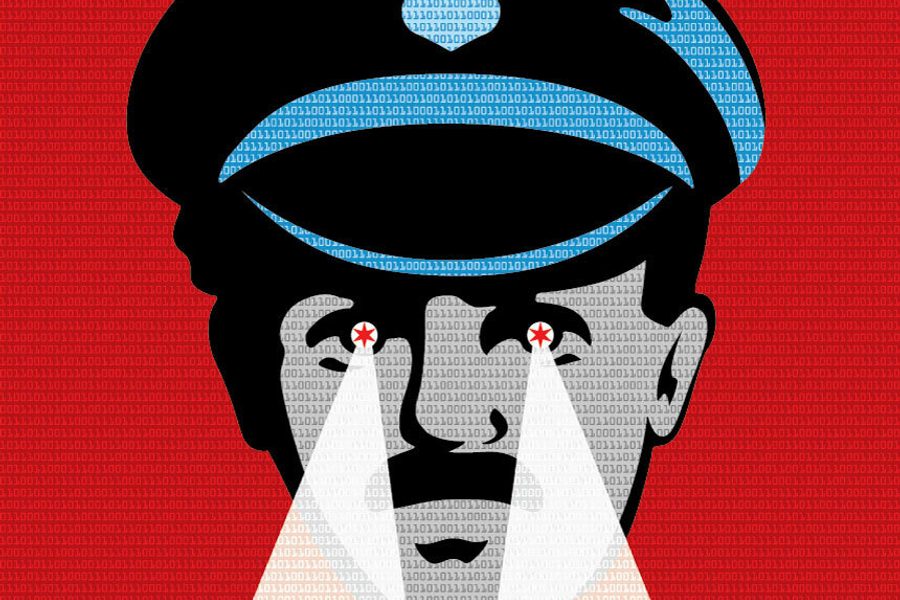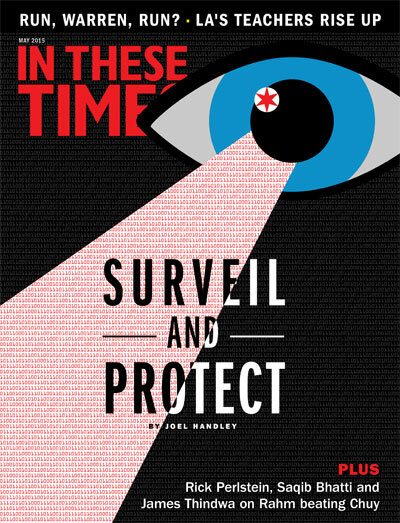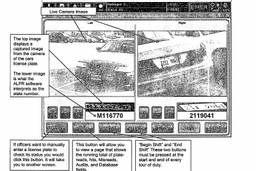Who Do You Protect, Who Do You Surveil?
The Chicago Police Department has spent millions on high-tech spying equipment, including cell-phone tracking technology, but is extremely secretive about its use.
Joel Handley

On Black Friday, 2014, the biggest shopping day of the year, hundreds of protesters marched to Wicker Park, a trendy neighborhood on Chicago’s northwest side. It was the third stop in a day-long march from one commercial district to the next: starting at downtown’s Magnificent Mile, then heading north to an Apple Store, then west. Four days after the grand jury decision not to indict Ferguson police officer Darren Wilson in the killing of Michael Brown, the event was part of a nationwide action decrying complacent consumerism in the face of a national tragedy. Wicker Park’s retail epicenter seemed an appropriate place to go.
A Chicago police officer, however, couldn’t figure out the route. He took to his radio and called in a request to the local “fusion center,” the Chicago Police Department (CPD) intelligence hub. “One of the girls, she’s kind of an organizer here, she’s been on her phone a lot. You guys picking up any information, uh, where they’re going, possibly?” the officer asked.
“Yeah, we’re keeping an eye on it.”
The conversation was quick, but when the audio from the call leaked online, activists saw proof of something they’d long suspected: Chicago police were tracking their cell phones, using a controversial new technology.
The StingRay — both a brand name and a generic term — is a suitcase-sized device that acts as a wiretap for the wireless age. But while a wiretap monitors a single line, a stingray acts like a roving cell phone tower, vacuuming in data from all nearby phones, tablets and other wireless devices. This includes call history and current and previous locations. Enhanced stingrays can also record and eavesdrop on phone calls.
An assortment of add-ons are now available: The FishHawk listens in on calls; the Harpoon broadens the StingRay’s range; the AmberJack antenna helps pinpoint individual phones; the KingFish analyzes call patterns, doing in one stroke what might have taken Detective Lester Freamon an entire season of The Wire to accomplish.
U.S. military and intelligence agencies developed stingray technology in the 1990s, and police departments began using it as early as 2003. Before receiving StingRays, police departments must sign non-disclosure agreements. It wasn’t until 2011, when the FBI presented information gathered from a stingray in court, that domestic use of the devices came to public attention. Civil liberties groups immediately sounded the alarm.
The ACLU says stingrays violate privacy rights because they capture information from every phone in the vicinity, not just a suspect’s. There are also concerns regarding Fourth Amendment restrictions on unreasonable search and seizure, since stingrays can penetrate the walls of a home and track a person’s movements even while inside.
The ACLU has identified at least 48 state and local law enforcement agencies that are using stingrays. While the Harris Corporation, maker of the StingRay brand device, assured the FCC the devices were for emergency use only (because they interfere with cell networks), the few available examples of their deployment show they are used for routine police work — and to spy on peaceful activists.
On November 12, 2003, for example, police in Miami-Dade, Florida, sought “retroactive authorization” from the county for the “emergency” purchase of a stingray on November 1. It was used to monitor protests at the Free Trade Area of the Americas Conference, according to a purchase request released to the ACLU.
Police departments have striven to keep the details of their stingray use under wraps. The Chicago Police Department denied owning the devices until April 2014, after local activist Freddy Martinez filed a Freedom of Information Act (FOIA) request. In response to that and subsequent requests from Martinez, CPD admitted it has owned stingray devices since 2005 and has purchased upgrades, antennae and software at a total cost of at least $640,000 — but has not disclosed how or when the devices are used.
Stingrays are part of a post-9/11 push by the federal government to step up local police departments’ intelligence-gathering and coordination. Since 9/11, the Department of Homeland Security (DHS) has given more than $34 billion to local law enforcement, in part for high-tech surveillance gear like stingrays and facial recognition systems. Seventy-eight DHS-funded fusion centers, where police officers work side by side with federal agents, have sprung up across the country, and 18,000 departments and agencies swap reports daily.
The Chicago Police Department has led the way in the new surveillance age. A six-month investigation by In These Times indicates CPD is using its new tools to target poor communities of color and peaceful activists organizing against the city’s power-holders.
New tech, same policing
Policing in Chicago has changed little since the department was founded in 1855. When the old “police force” (a group of part-time constables) couldn’t put down a construction workers’ strike, the city’s business class pushed the city government to fund a professional police department. CPD was tasked with shielding the well-to-do downtown residents from the surrounding rabble. Officers targeted the poorest immigrant group at the time: the Irish. In The Rise of the Chicago Police Department: Class and Conflict, 1850-1894, Sam Mitrani writes that while Irish Chicagoans made up only one-fifth of the city’s population, they accounted for two-thirds of arrests in the first six months of CPD’s existence. “While the police investigated a small number of serious crimes, the bulk of their activity consisted of patrolling the everyday activity of the immigrant working class,” Mitrani writes.
They also attempted to keep a lid on growing working-class unrest (which would erupt in the Haymarket affair in 1886). As early as May 1867, officers were monitoring rallies for the eight-hour workday. Police listened to soapbox speeches, infiltrated meetings, arrested speakers, intimidated strikers and shot demonstrators.
In the 20th century, various CPD intelligence units — known collectively as the Red Squad — broadened their target lists from labor unions and anarchists to, over time, Communists, black radicals, neighborhood organizations and New Left groups. Frank Donner, in Protectors of Privilege: Red Squads and Police Repression in Urban America, writes that officers stole mailing lists, burglarized homes and maintained files on hundreds of thousands of Chicagoans. One small community organization was infiltrated “apparently … because it opposed a cross-town expressway.” CPD launched its first effort at high-tech surveillance in the 1960s, using telephoto cameras to document the faces of protesters and rioters.
In 1982, a class action lawsuit quelled such abuses when a federal judge imposed a consent decree on the city of Chicago that prohibited “investigative activity … that is directed toward First Amendment conduct.”
However, playing on fear of black gangs and terrorism, Mayor Richard M. Daley convinced a federal court to ease the rules in 2001. The following year, undercover police infiltrated meetings of the American Friends Service Committee, a Quaker organization. In 2009, a judge dissolved the consent decree in full. In other words, at a time when CPD was testing out a new fusion center and an arsenal of high-tech surveillance gadgets such as stingrays, it was freed from the oversight that protected Chicagoans from investigation for exercising the First Amendment. Police could again conduct secret surveillance, so long as they filled out a brief “First Amendment worksheet” and received departmental approval.
Whom they chose to surveil was in keeping with the department’s long history. In addition to its covert obsession with activists, the department has never given up its day-to-day focus on the poor and working class. Today, African Americans are the city’s lowest-income racial group. Although they comprise only one-third of the city’s population, an analysis of 2010 arrest rates conducted by In These Times shows that 72 percent of all CPD arrests were of black residents (most frequently for alleged drug violations). Similarly, an ACLU of Illinois report released in March found that black Chicagoans were subject to 72 percent of “stop and frisks.”
Malkia Cyril, the founder and executive director of the Center for Media Justice, wrote in a recent Huffington Post op-ed that “indiscriminate and covert collection of private data expedites, expands and entrenches” such discriminatory policing.
CPD meets Big Data
In 2003, the Chicago Police Department introduced Police Observation Devices, or POD cameras — 30 large blue-and-white boxes mounted on poles — with the aim of filming open-air drug markets. In March 2005, the city trumpeted the program’s first success. Camera operators had spotted hand-to-hand drug transactions and notified a gang unit, which arrested three alleged West Side dealers.
Despite this slow start, CPD tech wunderkind Ron Huberman, the founder of the program, touted the cameras as “the future of crime fighting.” Giving a tour of the control center to a Wired magazine writer in 2005, Huberman showed off the cameras, becoming agitated when he spotted what he thought was a drug deal. “You see that guy? … He’s pitching dope — you can tell. Fucker,” Huberman is quoted as saying. They zoom in on the suspect (“so tight I can see the wisps of a mustache,” the writer says) and see him holding a brown bag and money. Huberman threatens to call in a bust then and there, but relents, saving the footage to use another day.
Evidently inspired by the program even before the first arrests, in 2004 Mayor Daley announced the creation of Operation Virtual Shield. In the downtown business district, 250 new cameras would be equipped with algorithms that could flag someone’s behavior as suspicious and alert the police.
These cameras proved a modest beginning to what would become the “most extensive and integrated” surveillance network in the country, according to former DHS Secretary Michael Chertoff. Funded by tens of millions of dollars in DHS grants, Chicago’s network has expanded to include cameras in more than 1,000 private businesses that have granted access to the city, plus 7,000 cameras in public schools and 3,200 on Chicago Housing Authority property. (Notably, 84.9 percent of the city’s public-school students and 93 percent of CHA households are black or Latino.) Another 23,000 cameras have been installed in Chicago Transit Authority stations, buses and trains.
By 2011, the last time CPD released complete stats, the number of POD cameras had swelled to more than 1,200. Of the 632 POD addresses currently listed on CPD’s website, more than 90 percent are in communities of color, primarily in the city’s low-income South and West Sides.
When CPD boasted in 2013 that the surveillance network had led to 4,500 arrests in a four-year span, Adam Schwartz, an ACLU attorney in Illinois, noted that this was less than 1 percent of all arrests. Numerous studies have shown that video cameras don’t reduce violent crime and do little to curb property crime. Given this, the ACLU wonders why Chicagoans should give up so much privacy, noting that the cameras’ zoom functions allow operators to closely watch targets and peer into cars and windows.
Meanwhile, in 2005, the department secretly bought its first stingray equipment, taking advantage of an Illinois law allowing police to make purchases outside the normal budgetary and procurement processes by using seized drug money. Between 2009 and 2014, CPD acquired multiple upgrades to its original devices, as well as AmberJack and KingFish attachments.
While it was buying stingrays, CPD introduced automatic license plate readers (ALPRs) with some fanfare. In 2006, Police Superintendent Phil Cline unveiled to the Chicago Sun-Times a “futuristic squad car” outfitted with an ALPR that could scan 3,600 plates per hour, automatically cataloging the date, time and GPS location in a central database. Police would be alerted if their car’s scanner caught a plate on a “hot list” of wanted vehicles. A 2007 CPD report explained that the ALPR-equipped cars were sent to high-crime neighborhoods, as well as “demonstrations and numerous special events throughout the city.”
Today, of CPD’s 25 ALPR-equipped squad cars, 22 are assigned to police districts and patrol areas with majority non-white populations. The five majority white districts share three of the cars. The department has also installed plate-scanning software in its POD cameras.
The cameras automatically send license-plate scans to a police database, which officers can check whenever they’re curious about where a certain car has traveled. The CPD also subscribes to a private ALPR database that lets it run plates against more than 3 billion records.
This retention of data is what most worries the ACLU’s Schwartz: “If you have hundreds of ALPRs around your city capturing hundreds of license plates every hour … you can punch in somebody’s license plate number and see where they’ve been, or after the fact, you can punch in the location of a protest three years ago and see who was there.”

The return of the Red Squad?
Chicago’s $1 million fusion center, opened in 2008, is staffed with rotating agents from the FBI, DHS and Drug Enforcement Agency, among others. They have access to a stream of data from 911 calls, mug shots, video feeds and police reports. The center got a makeover in 2014, with new wall-to-wall monitors piping in the feeds from the city’s surveillance camera network. Granted a tour in June 2014, NBC Chicago reported that if surveillance cameras recognize a target, a matching mug shot and criminal history appear on a monitor, suggesting that the fusion center runs advanced facial recognition software. (CPD never responded to an In These Times request for a visit.)
Elsewhere, fusion centers have taken their counterterrorism mandate as license to surveil Muslims. A document trove released to the ACLU in Northern California in 2013 shows that fear of Middle Eastern men animates many of the “suspicious activity reports” broadcast from California fusion centers. Samples include “Suspicious ME [Middle Eastern] Males Buy Several Large Pallets of Water,” and “Two middle eastern looking males taking photographs of Folsom Dam.”
There have been no such accounts in Chicago. However, its fusion center appears typical of a trend identified in a 2012 U.S. Senate report: Many centers have lost track of their counterterrorism directive. Chicago police are directed to notify the fusion center of “any significant or newsworthy event within the city” (emphasis in original). Of the more than 30 events listed as examples, most are run-of-the-mill policing. One, however, stands out: Police are directed to report “information concerning strikes, labor-management incidents or union controversies or the possibility thereof.” CPD has yet to respond to a November 2014 In These Times FOIA request asking for examples of reports coded under this category.
It’s clear that the center keeps a close eye on labor actions once they spill into the streets, along with all other protests and marches. In “private sector homeland security briefings,” the fusion center and CPD assemble impressive lists of upcoming rallies and actions. It then sends the schedule out to downtown office building managers and security teams. One such briefing from August 2013 lists six upcoming events, including an anti-drone protest, rallies for women’s rights and animal liberation, protests against banks and Boeing headquarters, and a march on City Hall “to stop police crimes.” The list is sandwiched between news of global violence — Egyptian police killed in an ambush, a Missoula bomb scare — and “significant dates” that tend heavily toward terrorism, such as the five-year anniversary of a suicide bombing in Pakistan. A disclaimer on the briefing “recognizes that Americans have constitutionally protected rights to assemble.”
How police and fusion center staffers get the protest information isn’t clear — whether through protest permits, infiltrators, stingrays, scouring of social media sites or some combination thereof. Jackson Potter, a staff coordinator for the Chicago Teachers Union (CTU), tells In These Times that both police and school board members regularly comment on things that are discussed in closed-door union meetings before they’re made public, though he thinks this is likely a function of moles cultivated by the school board, not police infiltrators. In 2012, the union expelled “for life” a CTU delegate whom FOIA requests revealed to be an informant for the school board, just as the union was preparing for a major strike.
Potter stresses that the union has a good relationship with the city police, which he chalks up to working-class solidarity. But he says he’s not naive about being targeted and suspects the police have files on many of the active CTU members and their community partners. He says that when the union applies for protest permits, officers will sometimes say, “We were wondering when you were going to call about this.”
Once the police arrive at a protest, they make no secret of some of their surveillance activities. Chicago attorney Jerry Boyle recalls that police “had the full-blown operation going” at a thousands-strong Take Back Chicago rally on October 10, 2011, where Occupy Chicago, unions and grassroots groups gathered to highlight the many ways big banks had devastated the city. Surveillance vans, undercover officers and handheld cameras were all deployed, says Boyle, a long-time legal observer for the National Lawyers Guild.
At protests and political events across the city, including the CTU picket lines in 2012 and recent demonstrations against police torture (after the Guardian revealed abuses at a Chicago police detention facility known as Homan Square), CPD officers routinely point cameras at crowds, sometimes shoving them in protesters’ faces. Babur Balos, a Chicago organizer, sees the cameras as intimidation. He jokes, “I think they’re running empty cameras.” CPD used that tactic in the 1960s.
The question remains: Is CPD using covert high-tech surveillance — stingrays, ALPRs — to investigate activists? Since the lifting of the consent decree in 2009, CPD intelligence units have conducted at least six “intelligence gathering” investigations into First Amendment-protected activities (one launched several months before the decree officially ended), according to documents released in March to the Chicago Reader. The redacted documents show that police utilized “electronic surveillance” and “undercover methods” against Occupy Chicago and protesters of the 2012 NATO Summit in Chicago. Another “intelligence gathering” mission began on November 7, 2014, two days after a protest against police brutality at CPD headquarters and as the Black Lives Matter movement was gaining steam in Chicago.
There’s no specification as to what “electronic surveillance” means, but given the indication that CPD used a stingray at the Black Friday protest in 2014 and its admission of deploying ALPRs at demonstrations in 2007, it could very well be using this gear to surveil activists. At the height of the 20th century Red Squad, officers wrote down license plate numbers outside meeting spots and protest sites, and stole mailing lists to map social connections. Today, a stingray deployed at the edge of an event, or an ALPR-equipped squad car circling through a union hall parking lot, could replace much of that legwork.
In the past, officers would use this type of information to harass activists, tip off employers and landlords to the activities of their workers and tenants, and create massive police files. Without court oversight, the only things preventing a return to such practices are the personalities of CPD officials and the professional standards to which they hold themselves.
Keep it like a secret
In These Times submitted 11 FOIA requests in November 2014 on a variety of CPD high-tech surveillance activities. After requesting extensions, the department has given partial answers to three of the 11 requests. Revised requests have yet to receive a response. The outstanding requests include files on individual activists, video footage from demonstrations and audits of officers abusing department computer systems.
Despite its apparent reluctance to disclose details of its spying, CPD actively promotes an image as an eager adopter of technology. In 2013, Chicago police claimed to have made the country’s first facial recognition technology (FRT)-assisted arrest, capturing a phone thief’s face on a train station camera and matching it to previous mug shots. However, in response to FOIA requests from In These Times and tech website The Verge, CPD said a search of records since 2013 turned up no reference to facial recognition technology. The Verge reports that the suspected phone thief’s arrest report did not mention FRT and his public defender was led to believe his client was identified in a police lineup.
To be fair, when it comes to disclosing its use of high-tech surveillance, CPD is a bit damned if it does, damned if it doesn’t: subject to FOIA lawsuits if it withholds information, but under duress from federal agencies and technology manufacturers to stay mum.
In December 2014, for example, the FBI and Harris — the defense contractor that manufactures StingRay — supported the CPD’s motion to the Cook County Circuit Court to dismiss Martinez’s FOIA lawsuit. The FBI argued that the release of information on StingRay would violate the Homeland Security Act and other federal laws, while Harris claimed that its proprietary trade secrets would be compromised.
The affidavits also noted the penalties CPD would face if it caved. Harris said that a release of its manuals or guides “would make it difficult for Harris to continue providing equipment.” Bradley Morrison, head of the FBI’s technology tracking unit, wrote a sterner admonition, claiming that disclosing details about StingRay could violate the International Traffic in Arms Regulations, “a felony punishable by up to 20 years imprisonment and up to $1 million per occurrence.”
Documents released in the course of the lawsuit suggest that CPD is not just hiding stingrays from the public, but also from judges, through an arcane trick police have used elsewhere across the country. Police can ask a judge for a “pen register” court order to obtain a phone’s incoming and outgoing call information from a cell phone company. In Washington, Florida and Maryland, court cases have shown that police routinely seek pen register court orders to request information that — unbeknownst to the judges — they’ve already procured, or plan to procure, via stingrays, thus covering up stingray use while securing nominal authorization.
Since July 2013, the Chicago Police Department has applied for at least 14 court orders that Sgt. Jack Costa wrote in an affidavit he “understood to authorize the use of” stingrays. The department refuses to produce these court orders, citing a federal law that allows pen register orders to be sealed. Despite having obtained the court orders, CPD claimed in a February response to another FOIA request that it had not used stingrays in the previous five months (a time span that includes the suspected police eavesdropping on the 2014 Black Friday march).
Privacy’s defenders
As technologies proliferate, location privacy has become a paramount concern to the ACLU and civil liberties groups such as the Electronic Frontier Foundation (EFF). Both stingrays and ALPRs, through their abilities to track historical and real-time location data, can violate location privacy, which the EFF considers a human right. Even the International Association of Chiefs of Police — a professional organization originally founded by Chicago police to track and detain fugitives — has raised concerns about the privacy problems posed by new technology.
Regulation efforts are taking shape, such as a pending Illinois Senate bill drafted by the ACLU that would limit police use of ALPRs to open investigations and limit the data retention period to 30 days. Similar efforts to force police to obtain search warrants to use stingrays have gained ground in a handful of states.
But even with regulation of high-tech surveillance, the question, chanted often at police officers during street protests, still stands: “Who do you protect? Who do you serve?”
According to Sam Mitrani, when leftist movements in the 19th century and mid-20th century realized that police were not working in their interests, huge mobilizations won concessions. More immigrants were hired to the force, and some of the worst civil rights violations were curbed. With a new movement for police reform and accountability swelling today, Mitrani says, “The more people who stand up and fight, the more demands they can make, the better off everyone will be.”
This article was supported by a grant from the Leonard C. Goodman Institute for Investigative Reporting.








